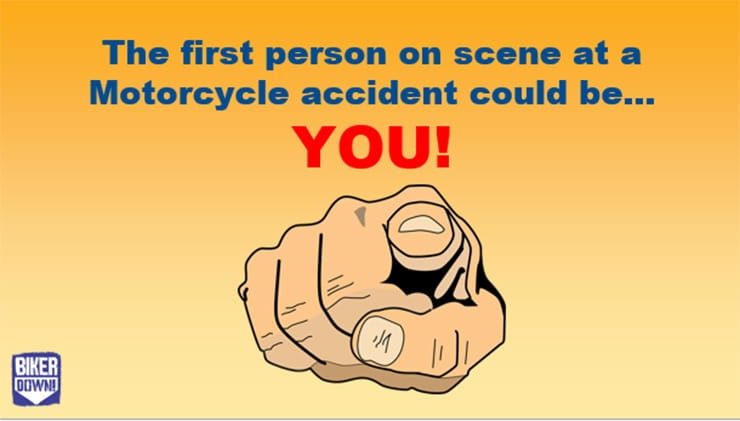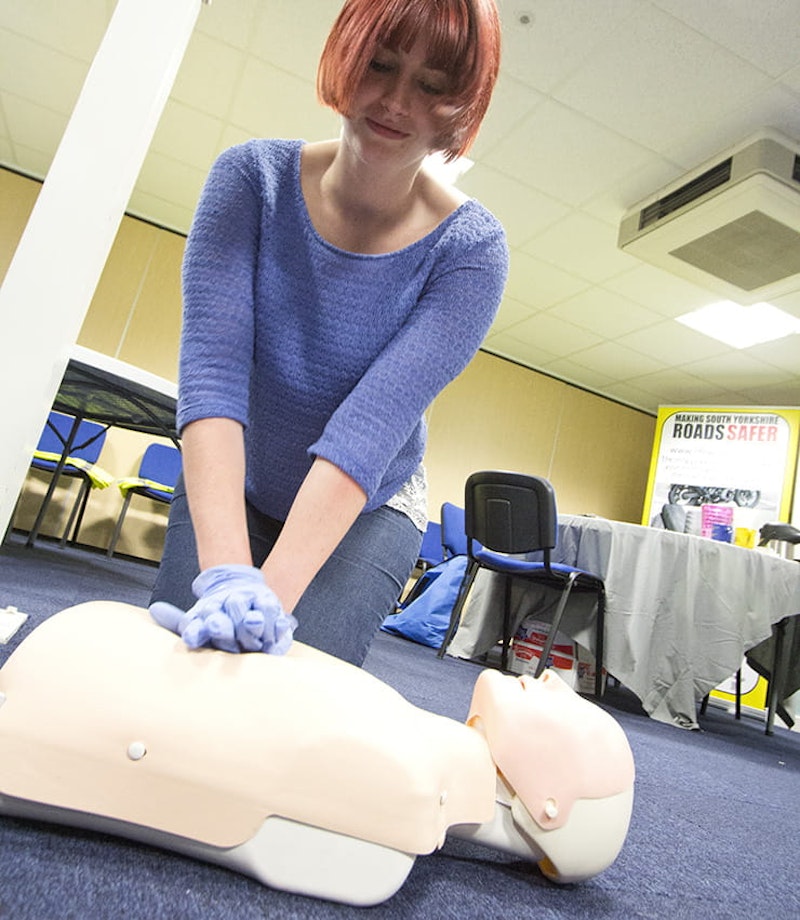Sign up to a FREE Biker Down course today and save a life!
By John Milbank
Consumer Editor of Bennetts BikeSocial
31.03.2023
Motorcycle Safety Week runs from 3 to 9 April 2023, and this year the National Fire Chiefs Council (NFCC) and Biker Down have come together with RoSPA, Road Safety GB, National Highways and TyreSafe to reduce the number of motorcycle rider injuries and fatalities in the UK.
The aim is to encourage riders to improve their road skills and adopt safer habits, as well as teaching them how to respond in the event of an incident as, between 2020 and 2021 – no doubt fuelled by an increase in couriers during the pandemic as well as people’s desire to avoid public transport – motorcyclist traffic grew by 17%. Unfortunately fatalities also grew, at a rate of 9%.
Would you know what to do if you saw an accident?
The NFCC and local First Response Services (FRS) are encouraging motorcyclists to sign up to a Biker Down course.
These three-hour sessions provide practical and potentially life-saving advice, including vital tips for riders around reducing their risk of being involved in a collision, what to do if they are involved in one, and what they can do if they see an injured motorcyclist.
Biker Down sessions are suitable for riders of all experience levels, whether riding for work, pleasure, or both.
Dan Quin, NFCC lead for road safety, said: “Motorcyclists are over-represented in collision and casualty statistics nationally. With an increase in the number of people using motorbikes for both commuting and enjoyment, our aim is to encourage riders to do all they can to ride safe and to be visible on the road.”
Biker Down courses are FREE, and run by your local fire service. Search for ‘Biker Down course near me’ to find the next dates in your area, or check the directory of all the Biker Down contacts, click here.
Biker Down courses are free, and could save your – or someone else’s – life
The NFCC guide to being seen
The average driver spends less than a second looking each way at junctions, so the NFCC says it’s vitally important that you’re seen and that you’re recognised.
“Being seen isn’t just about dressing from head to foot in Day-Glo yellow or fitting more lights to your bike than a Mod’s scooter has mirrors,” the guidance from NFCC says. “It’s about considering, before the start of the journey, the environments you’ll be riding in. What may get you noticed in a busy city street may not have the same visibility-enhancing qualities as the gear you’d wear on a late summer’s evening when scratching around on those idyllic country lanes.
“Dress to be different to the background but also try to present solid blocks of colour so your silhouette is easily recognisable at a glance. Consider the environment, background, light conditions, and colour clash to background potential.
“The thinking biker also considers positioning – think about the areas of the road that would be the best for you to be seen, which is especially important on the approach to junctions. As new bikers we’re constantly told to ‘stay dominant’, so as experienced bikers we must make full use of the available road space to give drivers the best possible chance of seeing us sooner. We need to be aware that size DOES matter and a motorcycle’s lack of it means we’re easily obscured.”
Biker Down sessions cover how to increase your visibility and how other vehicle drivers may struggle to see a motorbike due to ‘dazzle camouflage’, ‘motion camouflage’ and ‘looming’. Tried and tested rider tactics covering road positioning for visibility are covered to help make riding safer for both bikes and other vehicles.
Biker Down courses are FREE, and run by your local fire service. Search for ‘Biker Down course near me’ to find the next dates in your area, or check the directory of all the Biker Down contacts, click here.
John McGuinness on tyre safety
If anyone knows how important tyre safety is, it’s John McGuinness
Is your bike ready?
The NFCC points out that motorcycle maintenance is vitally important to staying safe, and suggests using ‘P.O.W.D.E.R.S. as your checklist…
Petrol: Check you have enough fuel for your journey to prevent breakdowns and putting yourself or others at risk.
Oil: Reservoirs have upper and lower marks, and the oil level is usually checked via a window in the engine casing – if not use a dipstick – with your motorcycle parked upright on level ground. The correct oil level will prevent your engine seizing up.
Water: Check coolant levels and keep them topped up as running out of coolant can cause your engine to overheat, which can lead to serious damage.
Damage/Drive chain: Check the motorcycle thoroughly for any signs of damage, which includes checking for chain tension and lubrication, and damage to the sprocket teeth. If your bike has a belt rather than chain, check for cracking.
Electrics: Check all the lights including brakes and indicators are working. Check cables are secure, and that they and the termination points are not worn as this can lead to failures.
Rubber: Check your tyres at least once a week, checking the pressures when your tyres are cold. Over-inflated tyres can affect grip, and under-inflated can cause problems with braking and handling. Look for cracks, bulges or objects embedded in the tread and make sure your tyres are wearing evenly. If they’re not, your tyre pressures may be incorrect, or the wheel may be incorrectly balanced. Ensure the tyres are clean and free of oil and grease, washing them with detergent if necessary. Check your tyre tread depth; it must be no less than 1mm around the circumference of the middle three quarters of the tyre. More information for motorcycle tyres can be found on the TyreSafe website, but if you have any concerns, you should get advice from a qualified professional or an approved fitting centre.
Self: Make sure you’re fit to ride, not tired or under the influence of alcohol, drugs or any medicines that may affect you. Plan your route, especially if you’re taking your motorcycle out on a longer ride, and make sure you take frequent breaks.

